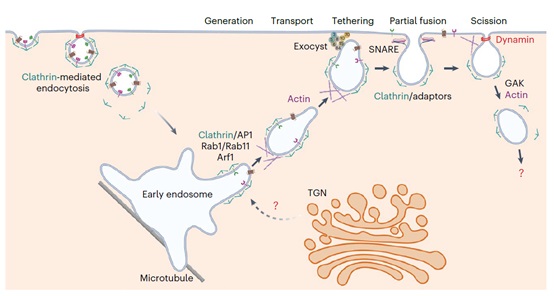Endocytosis and recycling control the uptake and retrieval of various materials in eukaryotic cells. Mammalian cells have developed several recycling routes including the relatively extensively studied “fast” and “slow” tubulovesicular recycling pathways. Nevertheless, endocytic recycling pathways beyond the canonical “fast” and “slow” recycling pathways remain largely unknown.
In a study published in Nature Cell Biology, a research group led by Dr. HE Kangmin from the Institute of Genetics and Developmental Biology, Chinese Academy of Sciences, identified a novel endocytic recycling mechanism with kiss-and-run membrane fusion, which they name the clathrin-associated fast endosomal recycling pathway (CARP). This study entitled “Clathrin-associated carriers enable recycling through a kiss-and-run mechanism” was published on September 19, 2024.
In this study, by utilizing a "coincidence detecting" lipid biosensor that selectively recognizes clathrin-associated structures containing PI(4,5)P2, the authors identified a population of lipid sensor-positive but AP2-negative clathrin-associated structures that transiently visit the plasma membrane. Using advanced 3D imaging and super-resolution imaging techniques, these structures were found to be intracellular clathrin/AP1-associated carriers. A remarkable discovery was that these clathrin/AP1-associated recycling carriers can partially fuse with the plasma membrane and are subsequently retrieved and released.
To characterize the molecular components and properties of the clathrin-associated recycling carriers, the authors conducted TIRF microscopy-based imaging screening. They identified a series of proteins recruited at various stages throughout the generation, approach, fusion, and retrieval of the clathrin-associated recycling carriers. Furthermore, they demonstrated that these carriers are generated from a subdomain of early endosomes that lack the retrieval complexes.
By tracking the endocytic recycling of agonist-stimulated β2 adrenergic receptors from the GPCR families and epidermal growth factor receptors from the receptor tyrosine kinases, the authors revealed that these clathrin-associated recycling carriers could mediate the fast recycling of signaling receptors back to the plasma membrane.
Thus, by leveraging innovative methodologies, the authors have uncovered a novel endocytic recycling pathway, CARP, characterized by employing a distinct set of molecular machinery to generate the recycling carriers and facilitate the unexpected kiss-and-run membrane fusion.
This work was funded by the National Natural Science Foundation of China and the National Key R&D Program of China.

A model summarizing the different trafficking steps of CARP, a novel endocytic recycling mechanism with kiss-and-run membrane fusion. (Image by HE Kangmin's group)
Contact:
Dr. HE Kangmin
Institute of Genetics and Developmental Biology, Chinese Academy of Sciences
Email: kmhe@genetics.ac.cn
 Contact:Dr. HE KangminInstitute of Genetics and Developmental Biology, Chinese Academy of SciencesEmail: kmhe@genetics.ac.cn
Contact:Dr. HE KangminInstitute of Genetics and Developmental Biology, Chinese Academy of SciencesEmail: kmhe@genetics.ac.cn CAS
CAS
 中文
中文




.png)
